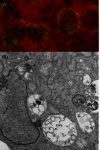NCBI Bookshelf. A service of the National Library of Medicine, National Institutes of Health.
Dean L, McEntyre J, editors. Coffee Break: Tutorials for NCBI Tools [Internet]. Bethesda (MD): National Center for Biotechnology Information (US); 1999-.
The most frequently reported sexually transmitted disease in the United States is caused by the parasitic bacterium Chlamydia trachomatis. Although about half a million cases of infection are reported annually, a more realistic incidence is around 4 million cases per year. This is because there is a large pool of asymptomatic individuals within the population. If left untreated, chlamydial infections can develop into pelvic inflammatory disease (PID) and can also cause severe but curable eye disease (trachoma).
The Chlamydia Genome Project consortium has recently sequenced the C. trachomatis genome. It has a circular chromosome of about 1,045,000 base pairs, about one-quarter the size of Escherichia coli. Analysis of the sequence has identified 888 protein-coding genes. Among these, some proteins appear to have an unconventional natural history.
The genome appears to have undergone an unusually high number of horizontal gene transfer events, suggesting that the parasitic nature of C. trachomatis provides greater opportunity for gene transfer to occur. More bizarre, though, is that some of the C. trachomatis proteins are more related to green plants than to other bacteria or their human hosts.
FabI and FabF, two chlamydial proteins involved in the fatty acid synthesis component of membrane biogenesis, seem to be most closely related to their plant counterparts, whereas plsB, involved in lipopolysaccharide biosynthesis, has only plant orthologs.
How this came to be relies on linking two pieces of information. First, a Chlamydia-like parasite has been found recently in Acanthamoeba, a free-living protozoan usually found in fresh water or soil but which may occur as a human pathogen. Perhaps Acanthamoeba represents the original host for Chlamydia, and served as a vector to transfer its Chlamydia parasite to humans. Second, inferences made from 16S-like RNA provide evidence that Acanthamoeba is phylogenetically related to green plants. One would therefore expect some Acanthamoeba and green plant genes to be highly related. Horizontal transfer between Acanthamoeba (host) and Chlamydia (parasite) could therefore give plant-like genes to Chlamydia. If this horizontal transfer occurred before Chlamydia was passed to humans, then it is possible that a human parasite has plant-like genes.
Analysis of the genome of Chlamydia will provide a starting point for a deeper understanding of other eukaryotic parasites, including those responsible for human disease.
Search PubMed for chlamydia adapting to live in human cells
Created: July 15, 1999
Click the link below to start an html tutorial.
How has chlamydia adapted to live in human cells?
Search PubMed for horizontal gene transfer
Created: July 15, 1999
Click the link below to start an html tutorial.
Horizontal gene transfer in pathogenesis
Use BLAST to search for chlamydia fatty acid synthesis enzymes
Created: July 15, 1999
Click the link below to start an html tutorial.
Chlamydia fatty acid synthesis enzymes match plant enzyme sequences
- Plant genes contribute to a sexually transmitted disease? - Coffee BreakPlant genes contribute to a sexually transmitted disease? - Coffee Break
Your browsing activity is empty.
Activity recording is turned off.
See more...

